|
The OPGI story
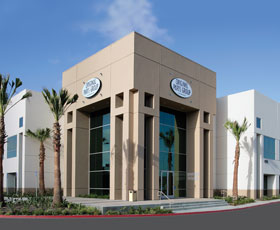
For those of you out there who are relatively new to “OPGI” — and by that I mean maybe you’ve ordered a few parts, received a few catalogs, but that’s about it — here’s a bit of history you may not be aware of. This is truly an inspiring story, and I’m sure you’ll enjoy it. So from now on, when you place your “I need parts” call to Original Parts Group, you’ll have a better understanding of what’s going on at the other end of the line.
What’s the recipe for success? OPGI owner Dave Leonard would tell you that sticking to your guns and shooting for the stars will put you on the right track.
|
|
Dave Leonard started out with less than $150 to his name back in late 1982, selling floor mats, decals, and emblems to Chevelle and El Camino owners. Back then, the Chevy A-Body world was ripe for the pickin’, and Dave determined he was just the man to set that world ablaze. His fledgling business was primarily a mail order service, but Dave also spent many days selling his small product line at local swap meets in Southern California. Dave operated out of a 2 car garage in Santa Ana, and called his “company” Chevelle Classics.
Within a year, Dave’s business had tripled, forcing him to move to an even bigger garage (this time, a two-and-a-half car unit in Garden Grove, CA). Chevelle and El Camino owners now had a choice of over 200 parts that Dave was offering. This was a good thing, since GM was discontinuing parts for these cars en masse.
In 1985, Dave moved into his first warehouse - a 1,200 square foot building in Anaheim. The business was really starting to catch on, as this move only lasted a year - requiring Dave to take his 4th location at a 2,500 square foot unit (also in Anaheim) in 1986. Chevelle Classics now offered 5,000 parts! Dave was spending serious money in the manufacturing end of the business, producing reproduction parts for the GM A-Body line.
In January of 1987, Chevelle Classics officially became “Original Parts Group”, and expanded further to offer more and more parts for the rest of the A-Body cars: Pontiac GTO, LeMans, and Tempest, Oldsmobile Cutlass and 4-4-2, Buick Skylark and GS, and Monte Carlo. The company now employed 20 people, and operated out of a 7,000 sq.ft. warehouse in Huntington Beach, CA. Around this time, OPGI started utilizing computer technology to process orders and manage inventory more effectively. Parts offered included many industry “firsts”, including reproduction lenses, injection molded interior parts, aluminum and chromed moldings and trim.
Fast forward to June of 1990, and it’s time to pack up and relocate again. Still in Huntington Beach, but this time to a newer building that’s more than double the size of the previous one. OPGI’s 16,000 sq.ft. building now housed completely separate warehousing facilities, sales offices, administrative space, showroom, and marketing offices. The product line-up offered over 20,000 parts for GM A-Body vehicles of 1964-1972 vintage, and for El Caminos right up ’til 1987. www.OPGI.com is rockin’ and rollin’, allowing customers the convenience of online shopping, 24 hours a day, 365 days a year.
In 2003, Dave and his thriving company have outgrown their facility on Gothard Ave in Huntington Beach, and plan a major move to Bolsa Avenue, also in “Surf City”. This time, the move is by far the most ambitious yet, acquiring a 54,000 square foot facility right opposite Boeing’s World Headquarters. Employees number over 50, and state-of-the-art computer systems are utilized, easily placing Original Parts Group at the top of the GM-A body parts food chain.
Come February 2008, OPGI relocates again, this time to a massive new building in Seal Beach, CA. This facility boasts a 110,000 sq.ft. footprint, with a mezzanine system allowing for expansion up to a quarter of a million square feet. Today, Original Parts Group, Inc., employees over 100 hard working people, and is the industry leader in GM A-Body parts and product development.
From selling floor mats at the swap meets, to the largest supplier of A-Body parts in the world. It’s a success story that inspires - and proves that hard work, persistence, and timing, are everything.
|
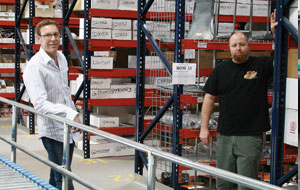
OPGI Founder Dave Leonard (left) and Chief Operations Officer Tony Genty

Just one small corner of OPGI’s massive showroom in Seal Beach, CA
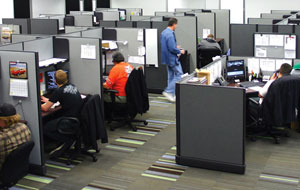
Sales department handles customer service calls from all over the world

The Seal Beach facility boasts 110,000 square feet and is expandable to 250,000 taking into account mezzanine space
|
|
 |
|
The Beach Cruiser

One morning in early March, I had the pleasure of hooking up with our friend Bill Bush in Huntington Beach, California. It’d been awhile since I’d been back to “The O.C.” (Orange County), and the opportunity to cruise on PCH with Bill in his bright red ’67 Chevelle ragtop was too good to pass up.
We’ll pull onto Pacific Coast Highway (California 1), top down, and let Bill do a little talking... his story is a good ’un...
“I’m a Cleveland boy and have been a car guy all of my life.
When the musclecar craze hit in the early ’60s, I was a part of it. I’ve owned a lot of cars over my lifetime, mostly Chevys. Among my favorites was a ’60 Biscayne with a 301, 30/30 Duntov cam and a 4-speed. I also had a ’61 Impala convertible with a factory 348, Tri-power and a 3-speed on the floor (which was soon switched to a 4-speed). I had a ’65 Chevelle that I bought with a 427, Tri-power and a four speed. I kept blowing up the big-block and after the third time, I traded it off for a small-block. Who knew?” Bill gives us a big grin, and continues “I obviously love 4-speeds.”
“I also had a big-block ’72 Monte Carlo, (automatic) when I met my wife. I sold it to buy an engagement ring. Six months after our wedding, we ended up in California. I loved Southern California from the first day I set foot here.
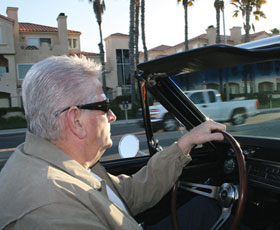
In 1982, my first project was to build a Harley. Unfortunately, my wife wasn’t as enthused, and after five or so years of riding, the bike got shoved to the back burner. It’s still in the shed, waiting like a woman scorned.
Sometime in 1987, I thought to myself, ‘what was as much fun to cruise as the Harley?’ and the first thing that came to mind was a convertible. I have always had a love for the ’67 Chevelle, and a rag top would be awesome...
Well, that turned out to be no small feat. I looked for about a year and still was not successful.
I found one up in San Francisco.The owner sent me pictures and I flew up there to buy it. The pictures must have been 10 years old. It was ragged. Forget it!” Bill laughs, and we hustle the red soft top through some slowly moving traffic.
“I would read every Auto Trader, every newspaper, and go to every Pomona swap meet. It was one Sunday early in 1989 when I was thinking of going to Pomona. I asked my wife Jan if she would like to go to see what I was up against. She reluctantly went. We were walking around, I turned around and there it was, a ’67 SS convertible on the back of a trailer in total pieces. It was just a shell. No front clip, motor, trans, interior, wiring, dashboard or anything else. I told Jan that that’s what I was looking for; I just didn’t want it like that. I talked to the owner and he told me it was a complete car, minus engine and trans. He said he had disassembled it, shot it with lots of Bolero red urethane, then lost interest. The paint was never rubbed and it was as hard as a rock. It had factory air and was straight though. It was not a matching numbers car, but back then I never even thought of that and didn’t care - it was a ’67 convertible! We walked around for a while and went back two or three more times to talk to him. We went home that night and talked about it. I called him up, we struck a deal, and we hauled it into my garage. It and all the pieces. All of the bolts and nuts for the entire car were in one box! No little plastic bags.”
When morning traffic permits, Bill gooses the Chevelle, and winds it up in 2nd gear. The car has more than plenty of grunt, chirping the tires with ease...when we’ve cleared the southern outskirts of Huntington Beach city limits, Bill goes on with his story...“I worked on this car every night for a little over a year - in the garage ’til 12:00 or 1:00 a.m. I just wanted a clean daily cruiser. Slowly it started coming together. With the help of my good friend Gary Hudson, we color sanded and rubbed the paint to a terrific shine.
I already knew that I was going to put a 427 in it. I located the motor from an engine builder, Lew Larsen.

I told him I wanted it to sound like an original 425 HP motor. He set me up with a 10.5:1 solid lifter, Crane 242/242 510 lift cam, good pushrods, roller tipped rockers, and some head work on a set of oval port heads.
Throw in a hidden MSD ignition, painted cap and rotor, and I was ready to roll. The choice was automatic or 4-speed. The fact that I was going to be driving it every day, I went with the Turbo 400. It already had a 12 bolt Posi with 3:08 gears. It also had the factory boxed control arms.”
It’s easy to tell Bill’s engine was built strong. It sounds super tough and pulls the Chevy hard through each gear. This is almost too much fun! The morning sun in early March is warm - warm enough to bring out the surfers and folks on roller blades. And the fact that we’re in a top down convert... ya gotta love SoCal...
Bill goes on “When it came to a complete interior, parts, top and exterior trim, I went to Chevelle Classics, or as they are now known, Original Parts Group. Those guys are the best. Back then, there were still a lot of NOS parts available, but there was no eBay. I had all of the original aluminum re- anodized, stainless re-polished and chrome re-chromed. I wanted it to look showroom stock; Redlines, Rallys, and all the correct 396 badges. I put it together with later model single-piston discs in front, although I still have the original 4-piston calipers.
I finished it in time for the Super Chevy show in Bakersfield in November of 1989. It came out far better than I could have hoped for. We cruised up to Bakersfield and did quite well. Unfortunately, I split the top of the radiator and we were gushing water and coolant all the way back. I was filling it with water at every stop! We made it home though, and took care of the repairs.
We started to attend local car shows and developed new friends and walls of trophies. Life was good!
I got bitten by the Hollywood bug and rented it out to a movie studio in 1992, when it was still an automatic. Cybill Shepherd drove it in a made-for-TV movie called “Stormy Weathers”. She was a P.I. They used another car for the chase scenes. They promised they would treat my car like a baby, but when it came back three weeks later on the back of an open trailer in the rain, I knew something was wrong. They had put something on the paint to take the shine out. Then they had tried to wax it back to its original shine before they delivered it back to me. They had gone into the interior with what must have been a stucco gun filled with Armor All. It was dripping off everything. The engine compartment got a good dose of some type of plastic sealer. We had to completely color sand and rub the paint. The original floor mats were missing and there was a rip in the convertible top. All in all, there was about $2,500 worth of damage. The kicker is that when I tried to collect my $3,000 for the rental, they told me they had filed for bankruptcy. I didn’t get a thing. So much for Hollywood.
In 1995, I decided I was getting tired of the automatic tranny, and a 427-powered car really needed a 4-speed. I sourced all of the pieces, and soon there was a Muncie in it. I changed the rear end to a 3:73. I also changed the badges to “427”. They never put a 427 into a Chevelle in 1967, but what if they did! I was loving it”.
Bill’s having a ball, and obviously never gets tired of this car. Who would? I just let him drive, and keep on the story...
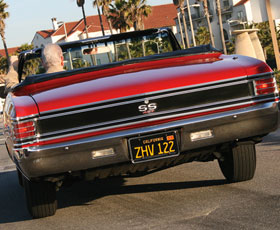
“I built this baby to drive and when the Power Tour began, I thought “this was for me”. It has been on two Power Tours from here to Mt. Clements, Michigan, in 1998 and ’99. Once with my friend Gary, and then the next year with my wife. Jan loves the car, but decided that going through Colorado with the top down and snow on the ground was not a girl thing. I have been driving it for 18 years now and I never get tired of it. I still drive it at least once a week.
The whole car came out so much nicer than I ever expected. We still go to a number of shows, and the car still holds its own.
To me, cruising down PCH in a red 1967 427 4-speed convertible is as good as it gets.
Would I ever put it back to an original matching-numbers car? Maybe, sometime when I retire or get tired of driving it. Would I ever sell it? Never!
Seven magazine covers over the years. How fortunate can a boy from Cleveland get who never thought he would get a black and white blurb!”
Our ride has come to an end. A perfect morning in a red hot Chevy ragtop. What a great way to start the day! Bill drops me back at my hotel, and roars off into the distance, bangin’ through the gears. One of those moments in time...
|
 |
CC’s first quiz:
Last installment of Colin’s Corner, I put out our first “GM Quiz”. Well, you’ve had just about a month to do all your digging for the answers. As I mentioned before, this ain’t no test (but there are wrong answers!) This is just something to have fun with, quiz your buddies, embarrass them, you know the drill. So here are the questions again, this time with the answers…
|
|
|
1. What was the last year the “Chevelle” name appeared on a Chevrolet?
Answer: 1977
2. Which 3 GM divisions utilized front wheel drive during the 1960s and 1970s?
Answer: Oldsmobile, Buick, Cadillac
3. What was the largest available engine (from the factory) in the 1970 Camaro?
Answer: L78 (396 cubic-inches)
4. What do the numbers used by Oldsmobile “4-4-2” stand for?
Answer: 4-barrel carburetor, 4-speed transmission, 2 (dual) exhaust
5. What was the first year the Impala hit the road?
Answer: 1958
6. What year did Pontiac’s GTO become its own model, and not just an “option” on the Tempest?
Answer: 1965
7. When did the name “Stingray” cease to appear on the Corvette?
Answer: 1977
8. What year did the first “boat tail” Buick Riviera appear?
Answer: 1971
9. What was the last year Cadillac produced a convertible?
(Modern day Caddys and modified/concept cars do not apply here!)
Answer: 1976
10. For which model year was the Monte Carlo introduced?
Answer: 1970
11. When did the first “Heavy Chevy” model arrive on the scene?
And which Chevrolet model was it based on?
Answer: 1971, based on the Chevelle
12. What do the letters “GTO” stand for?
Answer: Grand Tourismo Omologato
13. What model year was the 350 cubic-inch V8 introduced in Chevrolets?
Answer: 1967
14. In 1968, what was the maximum allowable cubic-inch displacement for the
A-body line-up, as dictated by GM Corporate?
Answer: 400
15. What was the first year Pontiac utilized the front “soft nose” urethane bumpers?
Answer: 1969
16. What was the model name given to Oldsmobile’s “glass paneled roof”
Station Wagons during the ’60s and ’70s?
Answer: Vista Cruiser
17. What was the last year for side vent windows on GM A-body vehicles?
Answer: 1969 (on sedans and station wagons)
18. In 1970, which GM division produced the “Rallye 350”?
Answer: Oldsmobile
19. What do the words “El Camino” mean?
Answer: The Way
20. What was the name of the Chevrolet/Pontiac “half-breed” A-body produced by
General Motors of Canada during the 1960s?
Answer: Beaumont
|
|
 |
|
Colin’s Corner Project 1969 Buick Special Update!

The ’69 Buick Special goes in for a facial. Part 1
If you’ll recall, last issue of CC the project Buick had just emerged from the paint booth, looking factory fresh. Well, the car is being sanded now, and next month, I should have some new pics for everyone to enjoy. In the meantime, I did manage to tackle an eyesore that’s been nagging at me for some time. That would be the dash area - that thing you look at every time you get in the car - the thing that stares back and says “hey, I’m butt ugly, fix me, now!”
If we’d had something a little less “unique” (like a Chevelle for instance), we could have just ordered up a whole new bezel from Original Parts Group. But noooo, we like to do things the hard way!
Not only has this dash bezel seen its share of normal wear and tear over the past 40+ years, but it also suffered through some bonehead’s attempt at installing air conditioning. Just check out that nasty heater control area to the right of the steering column. Yep, that’s dried up contact cement. Looks like somebody literally tried to glue an aftermarket A/C control unit right over top of the factory heater control panel! Nice. Behind that panel, we also discovered they cut the 3 cables that operate the heater/vent controls. Does it get any better than this? It was time to get to work.
|
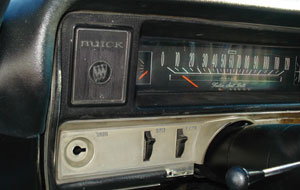
The overall bezel area is just plain worn out looking. Faded silver paint, yellowed areas from a lifetime of enduring cigarette smoke, lettering that’s faded and chipped. Our dash pad will get some much needed hygiene too...
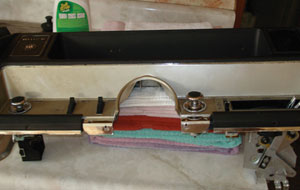
First step was removing the dash pad from the car. Then we pulled the entire instrument cluster with the black plastic bezel attached. The bezel is easy to remove - just held on with screws. No heater cables to worry about, they’d been clipped, remember?
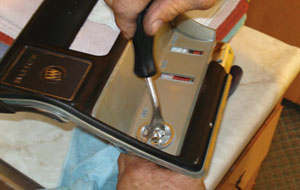
The bezel gets stripped of any and all parts that are attached. Headlight switch (and bezel), wiper and washer control switches, lighter (and bezel), and of course, heater controls.
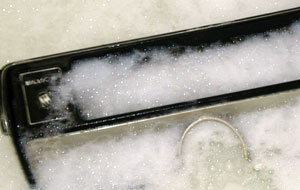
It’s time to remove the bulk of all those years of dust, grease, and cigarette smoke residue. We gave our bezel a warm bath in a grease-removing dish detergent.

Some areas of peeling paint were worked over gently with 000 grit steel wool. Go easy here, avoid scratching!

In preparation for paint, we start the masking process. We used 3M’s Scotch Blue “Painter’s Tape for Multi Surfaces #2090”. Small pieces were used to go around any corners or curves. The tape needs to be burnished to adhere properly.

Here we’ve masked the entire area that won’t see any silver paint. The area that will be painted has been thoroughly dried, light sanded, and wiped with a lint-free rag.
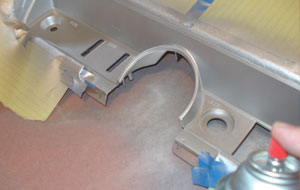
After experimenting with various “silver” rattle can spray paints (on scrap plastic, or course), we decided RUST-OLEUM’S 7515 Aluminum did the best job of matching GM’s factory finish.
There’s lots more to go, so we’ll finish up our dash resto in the next installment of Colin’s Corner. We’ve got a dented dash pad to deal with too! See ya next month!
|
|